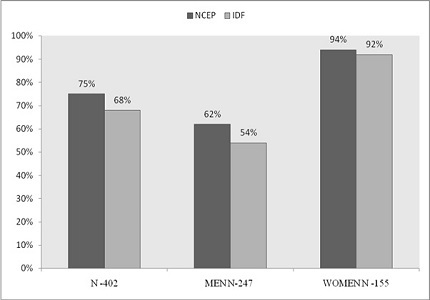The waistline of Indian men is expanding faster than women with general obesity and abdominal obesity reaching a epidemic in Indian subject with diabetes
Abstract
Background & Objectives: People with obesity and overweight are increasing in India. This study aimed at determining the prevalence of generalized and abdominal obesity in diabetics and comparison between genders.
Methods: An observational study held at Diabetes centre, between 2013-2014. Classification of obesity was done using WHO and IDF criteria for BMI in Asians, while Waist Circumference and WHR per IDF criteria. WHO Asia Pacific guidelines were used to define overweight [body mass index (BMI) ≥23 kg/m2 but <25 kg/m2, generalized obesity, BMI≥25kg/m2), abdominal obesity, waist circumference ≥90 cm in men, ≥80cm for women). 4504 subjects (men 2741, women 1763) with diabetes aged ≥ of 25 were recruited.
Results: The prevalence rates were 2, 13, 31 & 54 % women and 3, 23, 48, & 26% men were lean, normal, overweight and obese respectively. Comparing the waist circumference between men and women with IDF criteria 65% men (n=9235) and 89 %( n=8175) have a WC above the normal. Waist hip ratio, identified higher prevalence rate in men (89%) compared to women (76%) and WHR was a sensitive index compared to WC.
Interpretation & Conclusions: Higher prevalence of abdominal obesity compared to general obesity in diabetic population affected both genders similarly. Both general and abdominal obesity prevalence are higher in women than men. Our study found that AO had a higher prevalence in men contrary to the belief that women have higher AO. Abdominal obesity is directly linked to increased morbidity.
Downloads
References
Source: Country statistics and global health estimates by WHO and UN partners http://www.who.int/gho/en/ .http://www.who/chp/chronic_disease_report/en
Flegal KM, Kit BK, Orpana H, Grau bard BI. Association of all-cause mortality with overweight and obesity using standard body mass index categories: a systematic review and meta-analysis. JAMA. 2013 Jan 2;309(1):71-82. doi: https://doi.org/10.1001/jama.2012.113905.
World Health Organization (WHO). Global health risks: 5. mortality and burden of disease attributable to selected major risks. Geneva: Switzerland, WHO; 2009. Available from: http://www.who.int/healthinfo/global_burden_disease/GlobalHealthRisks_report_full.pdf, accessed on February 3, 2014.
Extract of the Global Diabetes Scorecard Tracking Progress for Action, International Diabetes Federation. http://www.idf.org/global-diabetes-scorecard/.
Mohan V, Deepa R. Obesity and abdominal obesity in Asian Indians. Indian J Med Res. 2006 May;123(5):593-6.
Bhardwaj S, Misra A, Misra R, Goel K, Bhatt SP, Rastogi K, Vikram NK, Gulati S. High prevalence of abdominal, intra-abdominal and subcutaneous adiposity and clustering of risk factors among urban Asian Indians in North India. PLoS One. 2011;6(9): e24362. doi: https://doi.org/10.1371/journal.pone.0024362. Epub 2011 Sep 20.
Misra A, Khurana L. Obesity and the metabolic syndrome in developing countries. J Clin Endocrinol Metab. 2008 Nov;93(11 Suppl 1): S9-30. doi: https://doi.org/10.1210/jc.2008-1595.
Anjana RM, Pradeepa R, Deepa M, Datta M, Sudha V, Unnikrishnan R, et al. The Indian Council of Medical Research-India Diabetes (ICMR-INDIAB) study: methodological details. J Diabetes Sci Technol 2011; 5: 906-14. J Diabetes Sci Technol. 2011 Jul; 5(4): 906–914.Published online 2011 Jul 1. PMCID: PMC3192597.doi: https://doi.org/10.1177/193229681100500413.
The Asia Pacific perspective: redefining obesity and its treatment. Regional Office for the Western Pacific (WPRO), World Health Organization. International Association for the Study of Obesity and the International Obesity Task Force: St Leonards, Australia; Health Communications Australia Pty Limited; 2000. p. 22-9.https://apps.who.int/iris/bitstream/handle/10665/206936/0957708211_eng.pdf?sequence=1&isAllowed=y.
World Health Organization (WHO). International Diabetes Federation. Definition and diagnosis of diabetes mellitus and intermediate hyperglycaemia; report of a WHO/IDF consultation. Geneva: WHO; 2006.
Diet, nutrition and the prevention of chronic diseases. World Health Organ Tech Rep Ser. 2003;916: i-viii, 1-149, back cover.https://www.who.int/dietphysicalactivity/publications/trs916/en/.
Bell AC, Ge K, Popkin BM. The road to obesity or the path to prevention: motorized transportation and obesity in China. Obes Res. 2002 Apr;10(4):277-83.doi: https://doi.org/10.1038/oby.2002.38.
.Misra A, Singhal N, Khurana L. Obesity, the metabolic syndrome, and type 2 diabetes in developing countries: role of dietary fats and oils. J Am Coll Nutr. 2010 Jun;29(3 Suppl):289S-301S.doi: https://doi.org/10.1080/07315724.2010.10719844.
Pandey RM, Gupta R, Misra A, Misra P, Singh V, Agrawal A, Dey S, Rao S, Menon VU, Kamalamma N, Devi KP, Revathi K, Sharma V. Determinants of urban-rural differences in cardiovascular risk factors in middle-aged women in India: a cross-sectional study. Int J Cardiol. 2013 Feb 20;163(2):157-62. doi: https://doi.org/10.1016/j.ijcard.2011.06.008. Epub 2011 Aug 30.
Joshi SR. Metabolic syndrome--emerging clusters of the Indian phenotype. J Assoc Physicians India. 2003 May;51:445-6.http://www.japi.org/may2003/Editorial_2.pdf.
Mohan V, Sandeep S, Deepa R, Shah B, Varghese C. Epidemiology of type 2 diabetes: Indian scenario. Indian J Med Res. 2007 Mar;125(3):217-30.doi: http://www.icmr.nic.in/ijmr/2007/march/0302.pdf.
Pettigrew R, Hamilton-Fairley D. Obesity and female reproductive function. Br Med Bull. 1997;53(2):341-58.doi: https://doi.org/10.1093/oxfordjournals.bmb.a011617.



 OAI - Open Archives Initiative
OAI - Open Archives Initiative


